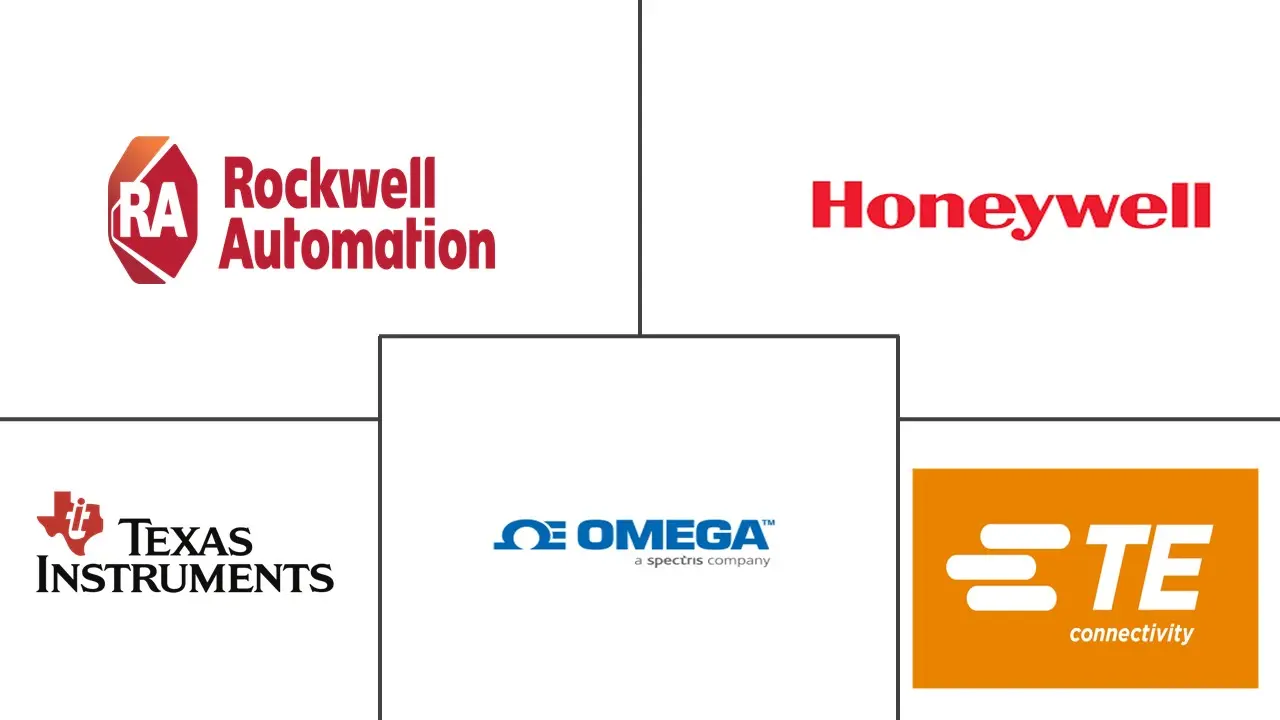Europe Sensors Market Size and Share
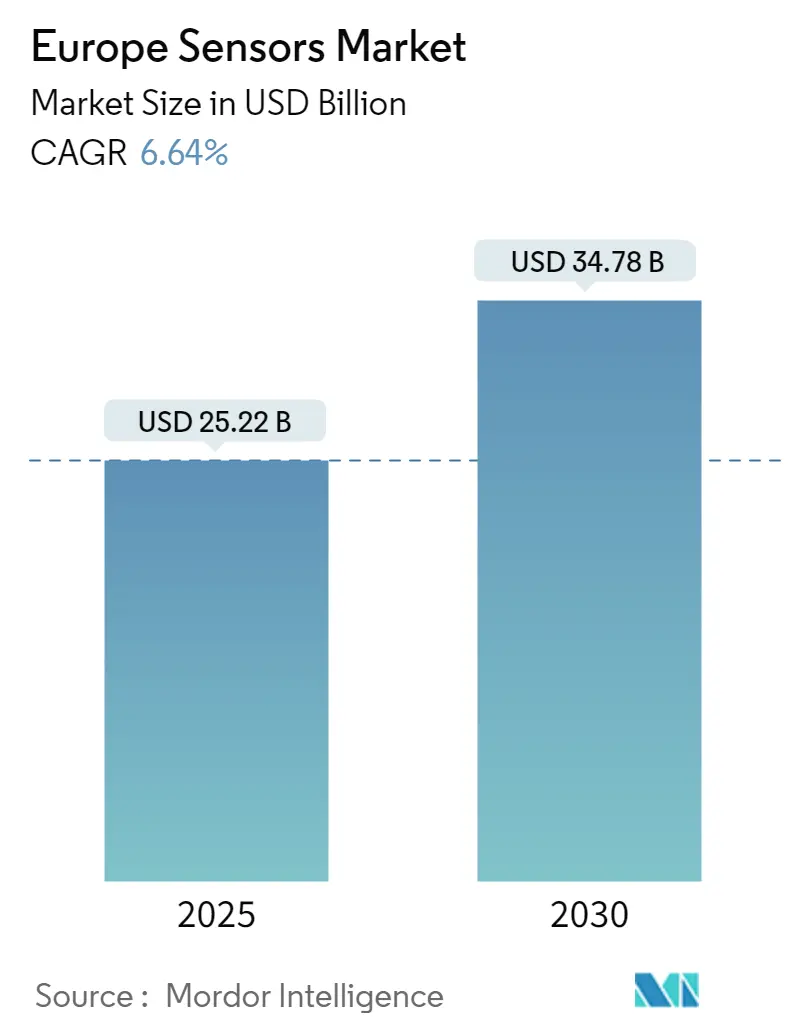
Europe Sensors Market Analysis by Mordor Intelligence
The Europe Sensors Market size is estimated at USD 25.22 billion in 2025, and is expected to reach USD 34.78 billion by 2030, at a CAGR of 6.64% during the forecast period (2025-2030).
Demand for intelligent sensor technology is rapidly expanding, from navigation systems in smartphones to driver-assistance systems. Sensors play an increasingly crucial role in winning the technology. Megatrends like the Internet of Things (IoT), wearable systems for health monitoring, and vehicle automation are significant drivers behind the growing demand for sensors.
- In the European sensor market, innovations in sectors like healthcare, automotive, defense and aerospace, and consumer electronics are said to be responsible for the growth. Another factor propelling the market is several government investments and initiatives to improve semiconductor production capabilities.
- In May 2024, Dexcom launched the Dexcom ONE+ continuous glucose monitor (CGM), in the UK. Drawing on insights from both users and healthcare experts, Dexcom has fine-tuned its established sensor design for the ONE+. Notably, this iteration features the advanced G7 sensor, a significant upgrade from its predecessor, which relied on the G6 sensor.
- However, high initial costs and operational concerns are the major factors anticipated to restrain the market's growth over the forecast period. Further, high-quality raw materials are vital for manufacturers as an essential part of producing superior sensors. Metals and alloys used in manufacturing include platinum, copper, silicon, tungsten, nickel, and alloys, which are further categorized into type-K, type-M, type-E, and type-J. Fluctuations in prices and supply of raw materials could also cause hindrances in the growth of the sensors market.
- The UK's Department for Science, Innovation, and Technology unveiled the National Semiconductor Strategy, committing to invest GBP 1 billion over the next decade. This investment aims to enhance infrastructure accessibility, bolster research and development efforts, and foster increased international collaboration, with an initial allocation of up to GBP 200 million earmarked for the years 2023-2025.
Europe Sensors Market Trends and Insights
Automotive Industry to Hold a Significant Market Share
- Automotive is one of the critical industries driving the demand for sensors due to their wide range of applications. The need for sensors in the automotive industry may increase significantly due to rising auto sales owing to the rising per capita income in emerging nations, EV adoption, and the automation of vehicles.
- Sensors are broadly used in the automotive industry to monitor different aspects of a car, including its temperature, coolant system, oil pressure, and speed. The growing need for safer and cleaner vehicles drives the demand for sensors in the automotive industry. For instance, sensors provide information regarding the engine's clean and effective fuel combustion, which helps significantly reduce exhaust emission values and fuel consumption.
- The possible applications for several sensor types may also be fueled by several government regulations and initiatives to promote the use of electric vehicles. For instance, in June 2022, the European Parliament voted to support the 2035 sales ban on diesel and gasoline vehicles. According to EMEA, battery electric vehicle share is anticipated to surpass 70% by 2030 and reach almost 30% of the European market by 2025. Due to these factors, pressure, temperature, inertia, and other sensors will likely be required in the automotive industry.
- With amendments in the vehicle safety system in the General Safety Regulation, new safety features are being introduced in the market, such as advanced emergency braking systems, tire pressure management systems, lane departure warning systems, and driver seatbelt reminders. Such mandatory government regulations in the European countries levied by the EU are expected to increase the demand for sensors in the market.
- According to the European Automobile Manufacturers Association (ACEA), European Union has witnessed an increase in new car registration, in November 2022, 829,823 new cars were registered which has grown to 885,580.57 in November 2023.
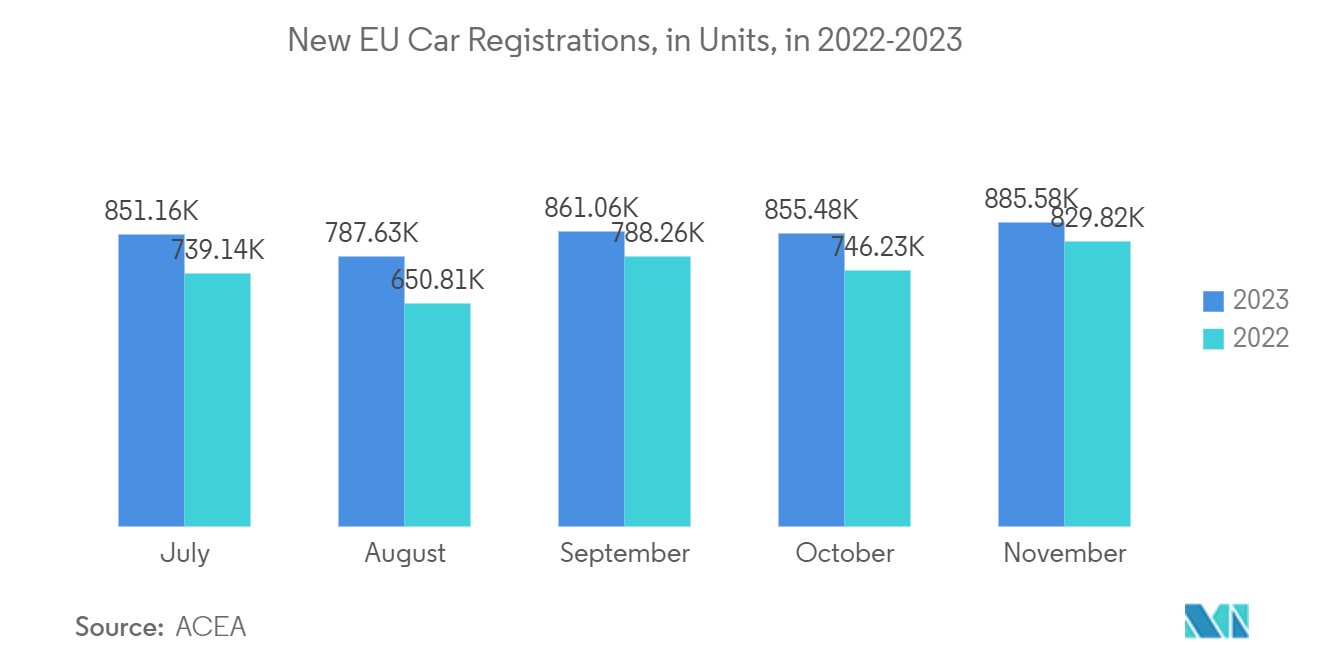
Consumer Electronics to Drive Market Growth
- Smartphones are one of the key products that employ many sensors. From the camera, display, and touch-up to distance and proximity measures, sensors have a wide range of smartphone usage. Thus, the increasing usage of smartphones impacts the market studied.
- Proximity and temperature sensors are common in all modern computers and associated devices. Non-contacts are preferred with proximity sensors to reduce wear and tear. Temperature sensors, the most well-known sensor in a computer, control the amount of internal heat produced by processors and related circuitry to prevent overheating or freezing.
- Sensing devices are used in more smart home applications as smart structures gain popularity. The need for sensors is anticipated to increase due to the growing popularity of smart consumer electronics, IoT devices for smart homes, and technological advancements and innovations. The growing use of wireless technologies, propelling the market for smart consumer electronics, is anticipated to open up new market opportunities for sensors.
- The region's expanding consumer electronics market is anticipated to open new application possibilities for sensors. For instance, consumer electronics accelerometers use the capacitive detection sensing principle to measure changes in linear motion. For mobile applications, the interrupt feature of sensors offers an extra special benefit, such as a battery-saving mode or free-fall detection. The market studied is anticipated to grow in response to the rising need for consumer electronics with low power requirements and longer battery lives in nations like the United Kingdom, Germany, and France.
- According to GFU, in 2023,smartphone sales generated revenue of roughly EUR 13,799 (USD 14925.21 million) in Germany. They are anticipated to grow more in the future, thereby driving the sensor market in the region.
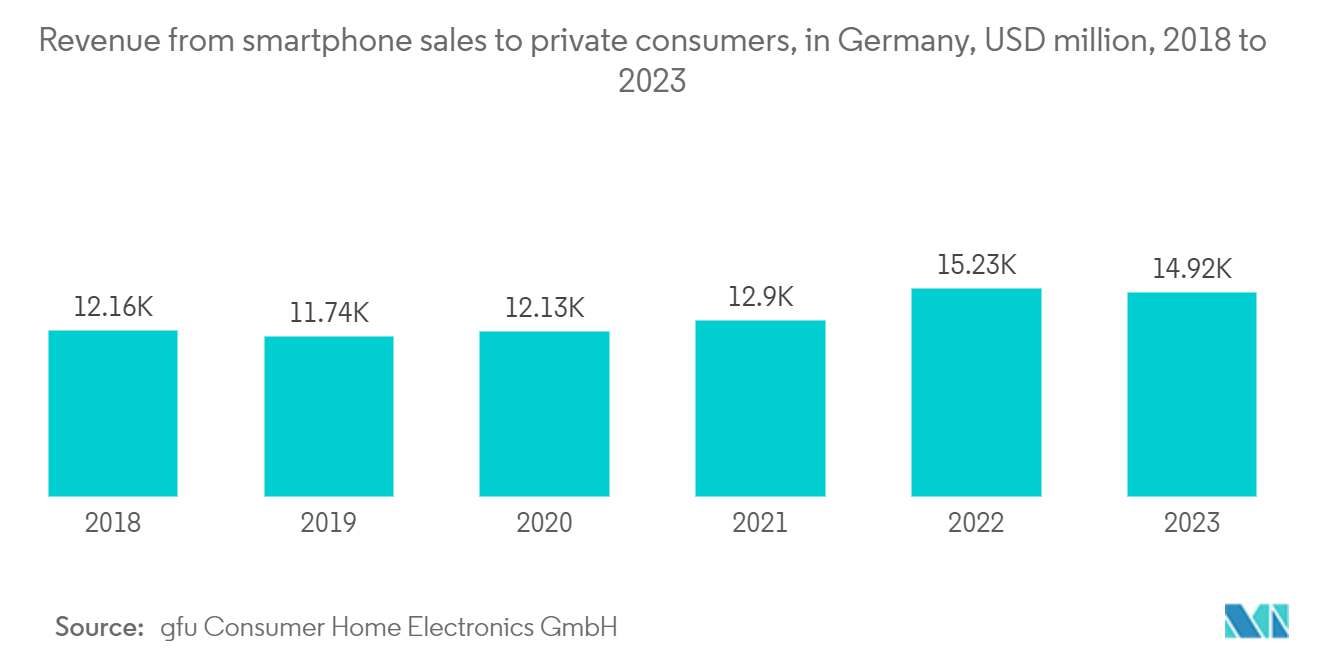
Competitive Landscape
The European sensor market is moderately fragmented due to several market players in the region. Some of the key players include Honeywell, Rockwell, Siemens, and Infineon.
- January 2023 - Elliptic Labs, a global AI software company and the world leader in AI Virtual Smart Sensors, announced the launch of its AI Virtual Distance Sensor. This sensor is a 100% software-only solution that allows devices to dynamically calculate the distance between devices, offering relative location detection.
- September 2022 - SMP Europe announced a new range of NOx sensors. The 25-part numbers cover a broad range of famous European vehicle manufacturers. Introducing these new sensors strengthens SMP Europe's position as an industry leader in Engine Management and Emissions components. NOx sensors will deliver a welcome addition to a portfolio already supporting the aftermarket with a wide selection of high-quality components to replace well-known high-failure parts.
Europe Sensors Industry Leaders
-
Rockwell Automation
-
Texas Instruments
-
Omega Engineering
-
TE Connectivity
-
Honeywell International
- *Disclaimer: Major Players sorted in no particular order
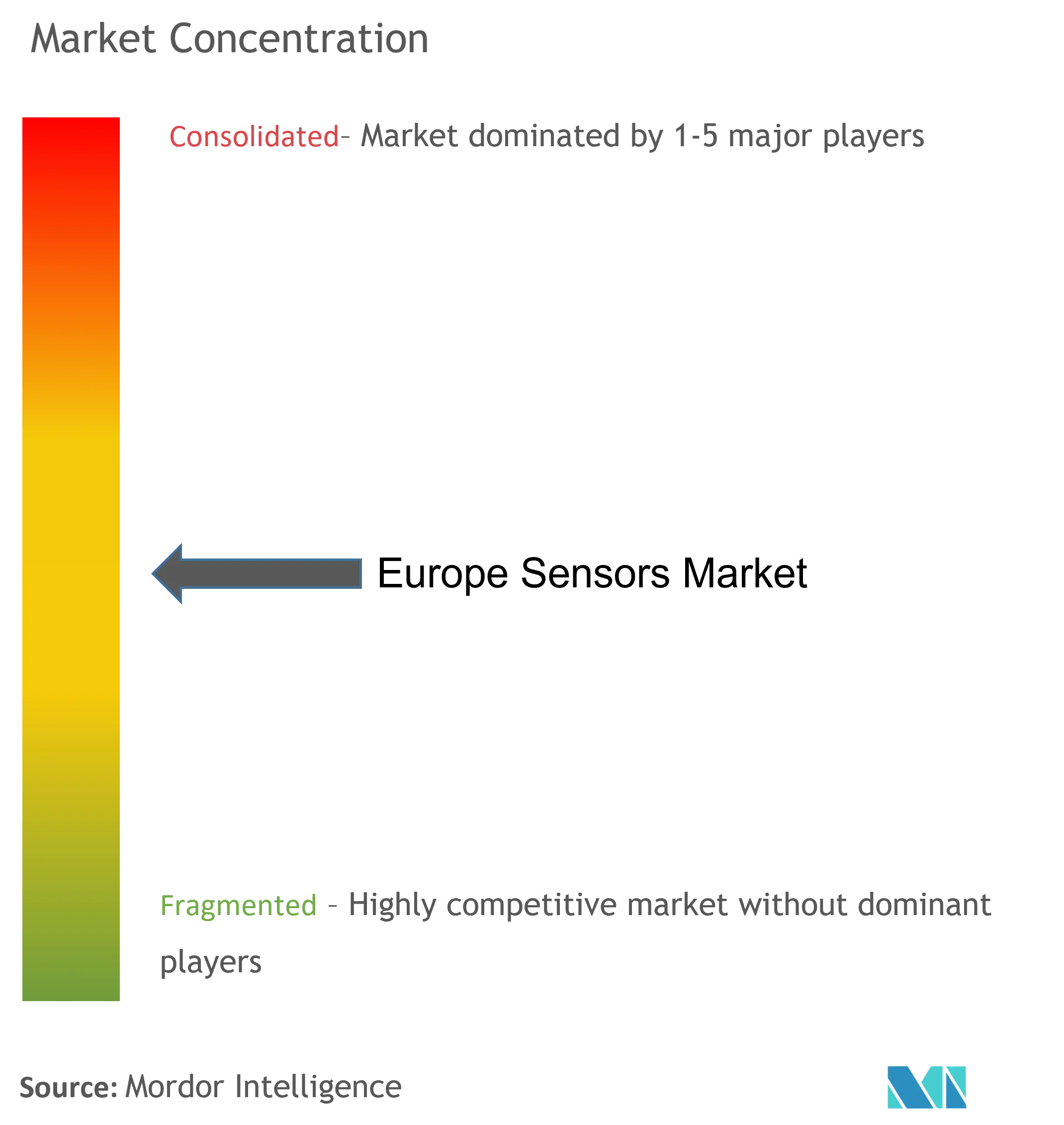
Recent Industry Developments
- March 2023: Terabee, a French sensor solutions technology company, announced a partnership with FIPOI, the Foundation for Buildings for International Organisations in Geneva, on a major people counting project as part of FIPOI's strategy to lower energy consumption and expenditure. By incorporating Terabee's people counting system with the CICG Building Management System (BMS), FIPOI desires to lower the conference center's energy consumption by automatically modifying its HVAC system according to real-time, accurate room occupancy numbers.
- January 2023: Lynred, a France-based infrared sensor maker, announced its new European project to develop high-performance devices for future defense systems. The Grenoble company is coordinating the EUR 19 million (USD 21 million) four-year effort, which also contains Xenics in Belgium and the German firm AIM Infrarot-Module, among all ten participants.
Europe Sensors Market Report Scope
A sensor detects and responds to the inputs from the physical environment. A typical input could be pressure, light, heat, motion, and moisture, among many others.
The European sensor market is segmented by parameters measured (temperature, pressure, level, flow, proximity, environmental, chemical, inertial, magnetic, vibration and other parameters measured), mode of operation (optical, electrical resistance, biosensors, piezoresistive, image, capacitive, piezoelectric, lidar, radar, and other modes of operation), end-user industry (automotive, consumer electronics (smartphones, tablets, laptops, and computers, wearable devices, smart appliances or devices, and other consumer electronics), energy, industrial and other, medical and wellness, construction, agriculture and mining, aerospace, and defense), and country (United Kingdom, France, Germany, and Other European Countries). The market sizes and forecasts are provided in terms of value (USD) for all the above segments.
| Temperature |
| Pessure |
| Level |
| Flow |
| Proximity |
| Environmental |
| Chemical |
| Inertial |
| Magnetic |
| Vibration |
| Other Parameters Measured |
| Optical |
| Electrical Resistance |
| Biosenser |
| Piezoresistive |
| Image |
| Capacitive |
| Piezoelectric |
| LiDAR |
| Radar |
| Other Modes of Operation |
| Automotive | |
| Consumer Electronics | Smartphones |
| Tablets, Laptops, and Computers | |
| Wearable Devices | |
| Smart Appliances or Devices | |
| Other Consumer Electronics | |
| Energy | |
| Industrial and Other | |
| Medical and Wellness | |
| Construction, Agriculture, and Mining | |
| Aerospace | |
| Defense |
| United Kingdom |
| Germany |
| France |
| By Parameters Measured | Temperature | |
| Pessure | ||
| Level | ||
| Flow | ||
| Proximity | ||
| Environmental | ||
| Chemical | ||
| Inertial | ||
| Magnetic | ||
| Vibration | ||
| Other Parameters Measured | ||
| By Mode of Operations | Optical | |
| Electrical Resistance | ||
| Biosenser | ||
| Piezoresistive | ||
| Image | ||
| Capacitive | ||
| Piezoelectric | ||
| LiDAR | ||
| Radar | ||
| Other Modes of Operation | ||
| By End-user Industry | Automotive | |
| Consumer Electronics | Smartphones | |
| Tablets, Laptops, and Computers | ||
| Wearable Devices | ||
| Smart Appliances or Devices | ||
| Other Consumer Electronics | ||
| Energy | ||
| Industrial and Other | ||
| Medical and Wellness | ||
| Construction, Agriculture, and Mining | ||
| Aerospace | ||
| Defense | ||
| By Country | United Kingdom | |
| Germany | ||
| France | ||
Key Questions Answered in the Report
How big is the Europe Sensors Market?
The Europe Sensors Market size is expected to reach USD 25.22 billion in 2025 and grow at a CAGR of 6.64% to reach USD 34.78 billion by 2030.
What is the current Europe Sensors Market size?
In 2025, the Europe Sensors Market size is expected to reach USD 25.22 billion.
Who are the key players in Europe Sensors Market?
Rockwell Automation, Texas Instruments, Omega Engineering, TE Connectivity and Honeywell International are the major companies operating in the Europe Sensors Market.
What years does this Europe Sensors Market cover, and what was the market size in 2024?
In 2024, the Europe Sensors Market size was estimated at USD 23.55 billion. The report covers the Europe Sensors Market historical market size for years: 2019, 2020, 2021, 2022, 2023 and 2024. The report also forecasts the Europe Sensors Market size for years: 2025, 2026, 2027, 2028, 2029 and 2030.
Page last updated on:
Europe Sensors Market Report
Statistics for the 2025 Europe Sensors market share, size and revenue growth rate, created by Mordor Intelligence™ Industry Reports. Europe Sensors analysis includes a market forecast outlook for 2025 to 2030 and historical overview. Get a sample of this industry analysis as a free report PDF download.
